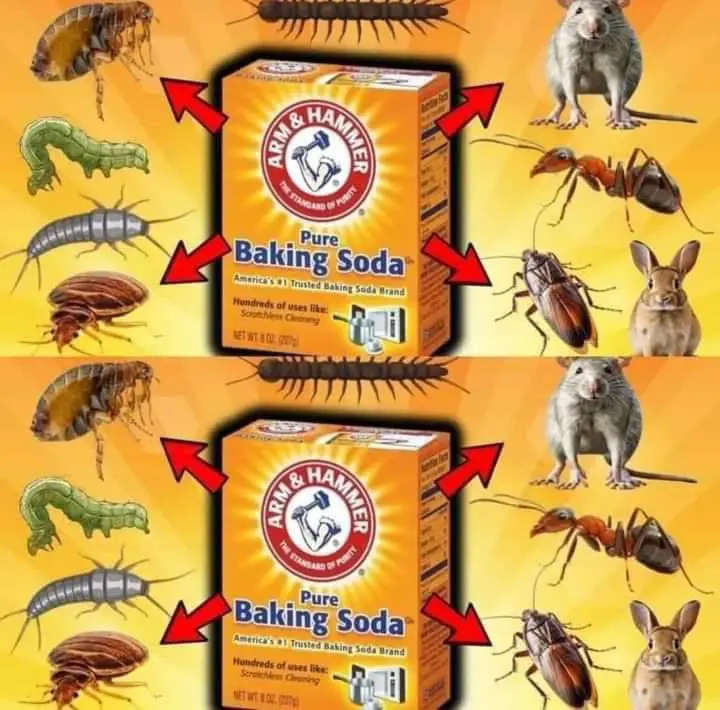Harnessing the Power of Baking Soda for Pest Control
Have you ever thought about using a simple kitchen staple like baking soda to manage household pests? Baking soda is not only useful in baking and cleaning, but it can also act as an effective, natural pest control solution. Whether you’re dealing with fleas, mice, ants, or other common pests, baking soda might just be the environmentally friendly option you need.
Fleas:
Fleas can be a major issue, especially if you have pets. To tackle flea infestations, mix baking soda and salt in equal parts and sprinkle the mixture on your carpets and pet bedding. The combination dries out fleas and their eggs by absorbing moisture, leading to their elimination. Let the mixture sit for a few hours before vacuuming thoroughly to remove both fleas and their eggs.
Mice and Rats:
Rodents dislike the scent and taste of baking soda. Sprinkle baking soda in areas where you suspect mice or rats are frequenting, such as corners or behind appliances. For a more effective solution, mix baking soda with sugar to create an irresistible bait. Once ingested, the baking soda reacts with stomach acids, leading to internal disruptions that can help manage the rodent problem.
Cockroaches:
Cockroaches can be particularly difficult to eradicate, but baking soda is a helpful tool. Create a mixture of equal parts baking soda and sugar. The sugar attracts the cockroaches, while the baking soda disrupts their digestive system once ingested. Place this mixture in areas where cockroaches tend to hide, such as under sinks or in dark corners.
Ants:
Ants are attracted to anything sweet, which makes baking soda mixed with powdered sugar a perfect solution. Ants carry the mixture back to their colony, and the baking soda works to reduce their numbers. Sprinkle the mixture along ant trails and near entry points to tackle the infestation.
Bedbugs and Centipedes:
Bedbugs can be a nightmare to deal with, but baking soda can help. Sprinkle it directly on bed frames, mattresses, and areas where bedbugs are present. Baking soda absorbs moisture from their bodies, causing dehydration. For centipedes, dust areas where they commonly appear with baking soda. This disrupts their environment and can help keep them away.
Why Baking Soda Works
Baking soda’s effectiveness lies in its ability to dehydrate pests by drawing moisture from their bodies. Additionally, when combined with substances like sugar or salt, it can attract pests and create lethal reactions when ingested. It’s a non-toxic, affordable, and eco-friendly alternative to chemical pesticides, making it a safe option for homes with children or pets.
By harnessing the power of baking soda, you can manage a range of household pests in a natural and effective way!
The method of using baking soda for pest control involves leveraging its desiccant properties (ability to absorb moisture) and reaction with digestive acids in pests. Baking soda dehydrates pests or disrupts their digestive systems, leading to their eventual elimination. Here’s a step-by-step breakdown of the method for different pests:
For Fleas:
- Mixing Baking Soda and Salt: Combine equal parts of baking soda and salt. The salt acts as a drying agent, enhancing the effect of the baking soda.
- Application: Sprinkle the mixture onto carpets, pet bedding, and other areas where fleas are likely to hide.
- Let it Sit: Leave the mixture for a few hours. During this time, the baking soda and salt absorb moisture from the fleas and their eggs, killing them.
- Vacuum Thoroughly: After a few hours, vacuum the treated areas to remove dead fleas, eggs, and larvae.
For Mice and Rats:
- Create a Bait: Mix baking soda with sugar or another food item to attract the rodents.
- Placement: Place the bait near areas where you have seen rodents, such as behind appliances or in the pantry.
- Ingestion: Mice and rats will consume the bait. Once ingested, the baking soda reacts with the acid in their stomachs, producing gas that rodents are unable to release, causing fatal internal complications.
For Cockroaches:
- Mixing with Sugar: Combine equal parts of baking soda and sugar. The sugar attracts the cockroaches, while the baking soda harms them.
- Application: Sprinkle the mixture around areas where cockroaches are common, such as under sinks, along baseboards, and in kitchen cabinets.
- Cockroach Consumption: The cockroaches will eat the mixture. The baking soda reacts with acids in their digestive system, killing them.
For Ants:
- Sugar and Baking Soda: Mix equal parts of powdered sugar and baking soda.
- Sprinkle Along Ant Trails: Ants are drawn to the sugar and unknowingly carry the baking soda back to their colony. The baking soda disrupts their digestive process, reducing the colony over time.
- Monitor and Reapply: Check the treated areas and reapply the mixture as necessary to ensure complete eradication.
For Bedbugs:
- Direct Application: Sprinkle baking soda directly onto bed frames, mattresses, and any areas where bedbugs are present.
- Dehydration: The baking soda will absorb moisture from the bedbugs’ bodies, causing them to dehydrate and die.
- Vacuum: After a few days, vacuum the area thoroughly to remove any dead bedbugs and residual baking soda.
For Centipedes:
- Sprinkle in Common Areas: Dust baking soda in areas where centipedes are typically found, such as basements or bathrooms.
- Habitat Disruption: Baking soda alters the environment, making it less hospitable for centipedes, encouraging them to leave.
Why This Works:
- Dehydration: Baking soda absorbs moisture from pests, causing them to dry out and die.
- Digestive Disruption: When ingested, baking soda reacts with stomach acids in pests like rodents and insects, leading to a buildup of gases that they cannot expel, resulting in death.
- Non-Toxic: Baking soda is safe for humans and pets, making it an excellent alternative to chemical-based pest control solutions.
This method is simple, cost-effective, and uses common household ingredients, making it an easy solution for pest control!

